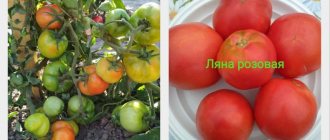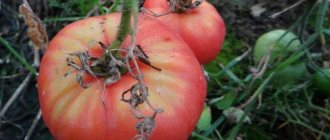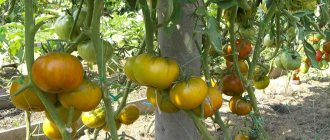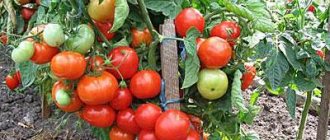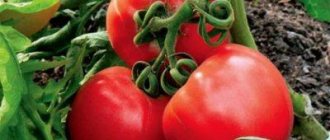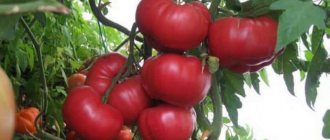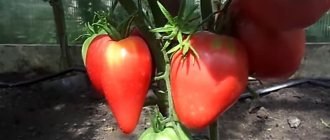Characteristics of the variety
The bush is classified as indeterminate - reaches a height of 120 to 200 cm. Fruit ripening is mid-early: 110-115 days pass from the time of sowing. The fruits grow in clusters of 5-8 pieces.
Fruit
Strawberry Tree tomatoes are bright red, dense, and have a sharp tip. They really resemble a berry in shape. The taste of tomatoes is sweet and sour. Weight – from 150 to 250 g. Pulp – fleshy and dense, with a high content of dry matter.
Tomatoes are good for salads and sandwiches. Smaller fruits can be preserved whole, larger ones - in pieces. They are successfully dried and used to make pasta and ketchup.
Productivity
With proper care, the variety gives good yields - 4-5 kg per bush. Typically, the yield is higher when grown in a greenhouse and when forming a bush with 1 stem.
For abundant fruiting, regular watering is more important for tomatoes than additional fertilizing.
Sustainability
The Siberian variety is resistant to seasonal cold, but does not tolerate drought well. He rarely gets sick, but needs regular preventive measures (especially against late blight and brown spot). Of the pests, it is most often affected by whiteflies and spider mites.
Care
Proper care will ensure a good harvest
Like any variety of tomato, the Strawberry tree needs proper care.
It is very important to water tomatoes in a timely manner and sufficiently. The yield depends on how strictly this point is followed.
In greenhouses, watering is carried out every 3-5 days. In open areas, it all depends on the weather - you can do it every day or once every 3-5 days. But you need to be careful that there is not too much moisture. This may affect the quality of the fruit - it will become watery and sour.
Stepsoning
Once a week it is worth inspecting the bushes and removing lateral shoots. They take on a lot of useful substances and moisture, but the tomato will not be on them. Therefore, it is necessary to get rid of stepchildren throughout the entire growth period, otherwise the fruits will be much smaller. It is also necessary to remove diseased leaves, because this prevents the spread of the disease.
Top dressing
Ashes in the amount of 300-500 g are poured into 10 liters of water, and crushed shells are used. If the choice fell on mineral ones, then superphosphate, which is added during the flowering and fruiting period, will ensure good yield. For 10 liters of water give 3 tbsp. l. facilities. It is especially indicated if the leaves have acquired a blue or rusty tint.
- brown spot;
- spider mite;
- greenhouse whitefly.
Under greenhouse growing conditions, tomatoes are often affected by brown spot. This disease occurs due to excessive watering or strong lighting. Treat with garlic solution and properly shade the light.
The description of the variety recommends using the drug “Ordan” to prevent late blight and alternaria. You can spray for the first time when there are already 4-6 leaves. The next ones will be in 7-10 days. It is necessary to treat with this product no later than 20 days before harvesting the fruits.
Picking tomato seedlings 2017
Tomato tree - Myth or Reality?
Tomatoes. Tomato tree? What will happen?
LET'S START GROWING A TOMATO TREE-2018/NEW SUPER METHOD!
Tall bushes are formed into 1 or 2 stems, side shoots are removed, and the growing point is pinched.
According to the characteristics, the Strawberry tree variety needs regular, but not excessive moisture. It does not tolerate drought, but due to the abundance of moisture it can produce watery fruits. After the procedure, the soil is loosened, the tomatoes are hilled, and the greenhouse is ventilated.
Landing technology
Tomatoes are most often grown in greenhouses, but they can also grow and bear fruit in open ground.
For greenhouse cultivation, seeds are sown in early March, and for open ground - in early April. Two months after sowing, the seedlings are usually ready for transplanting.
Sowing
Seeds must be soaked before planting
Before sowing, the seeds are soaked in a manganese solution for disinfection. A layer of soil 5-10 cm thick is poured into the tray and the seeds are laid out at intervals of 2 cm.
Then it is moistened with a spray bottle using warm, settled water, and covered with a second layer of soil 0.5-1 cm thick. The tray is covered with film and placed in a warm place, maintaining a temperature of 23-24°C.
Seedling
After 4-5 days, the first shoots appear. Now remove the film and water the sprouts with warm water.
The tray is moved to the windowsill and the temperature is lowered to 16°C (for 5-6 days). When the seedlings form 2 true leaves, they can be planted in separate pots. Two weeks before transplanting into open ground, the plants begin to harden off, taking them outside every day.
Transfer
Before planting, the soil in the garden bed is fertilized, loosened, and irrigated with a manganese solution. You can add ground eggshells and ash into the holes.
The bushes are planted at a distance of 50 cm from each other, having previously installed a trellis for future garter.
Plants are watered with warm water strictly at the root.
Tall bushes are formed into 1 or 2 stems, side shoots are removed, and the growing point is pinched.
It is extremely important to remove shoots growing from the ground - they do not produce ovaries, but draw nutrients onto themselves.
According to the characteristics, the Strawberry tree variety needs regular, but not excessive moisture. It does not tolerate drought, but due to the abundance of moisture it can produce watery fruits. After the procedure, the soil is loosened, the tomatoes are hilled, and the greenhouse is ventilated.
The optimal humidity for tomatoes is 45-55%. At higher humidity, the greenhouse is ventilated in a timely manner to avoid the appearance of fungal diseases.
Plants are fed once every 2-3 weeks, alternating organic fertilizers with mineral complexes. Mandatory care measures include regular weeding of beds to remove weeds. (To retain moisture in the soil and reduce the number of weeds, the ground can be mulched with peat.) Stems with heavy tassels require tying to a trellis.
Outdoor care
In the future, special attention should be paid to watering. The crop is very demanding of moisture, so it is best to organize a drip or ditch irrigation system. Such systems involve the removal of devices that supply water directly to the root system of each plant, which reduces the risk of moisture entering the above-ground part, and, accordingly, eliminates the risk of developing stem rot.
Fertilizing is applied only 3 times:
- 10 days after transplanting into open ground , use a liquid solution of mullein mixed with water 1:2 (300 ml per plant);
- with the appearance of the first buds , use a solution of wood ash of 10 liters per m², add 300 g of ash to this amount of water;
- after flowering with the appearance of the first ovary , a solution with yeast is used, a pack of yeast + 1 tbsp is added to 10 liters of water. l. sugar (this amount is enough to spray leaves and soil per m²).
Diseases and pests
Universal preventive measures include:
- compliance with the rules of crop rotation (never plant tomatoes immediately after nightshade crops and do not create tomato beds next to potatoes);
- control of humidity in the greenhouse (regular ventilation);
- weeding, loosening, mulching the soil;
- frequent inspection of the leaves of the seedlings, and during the fruiting period - the fruits;
- watering with potassium permanganate and ash solution;
- spraying with Bordeaux mixture and calcium nitrate.
Potential pests include spider mites, whiteflies, and aphids. At the first sign of an infestation, insects are collected by hand or washed off with soap and water. If manual primary remedies do not help, use insecticides (for spider mites - acaricides).
You can hang yellow glue traps in the greenhouse (sold in specialized garden stores). They can be used to both catch insect pests and to be guided by their appearance on traps about the need for treatment with insecticides.
Conditions for maximum fruiting
To stimulate the best harvest, use superphosphate fertilizer during flowering and fruiting (3 tablespoons per 10 liters of water).
Superphosphate should also be used if tomato leaves turn blue or acquire a rusty tint - this is a sign of phosphate starvation.
When planting seedlings in a greenhouse or open soil, you can add 10-15 g of superphosphate to each hole. This fertilizer nourishes the root system and improves the taste of the fruit; it is mineral and non-steroidal.
Tomatoes are very fond of potassium-nitrogen fertilizing; it should be applied the first time when moving the seedlings into the soil and the second time as soon as the first cluster begins to form.
A small list of potassium-nitrogen fertilizers that are used for both foliar and root feeding:
- Potassium monophosphate KH2PO4 - dissolve 1-2 g per liter in water.
- Potassium sulfate - solution no more than 0.1% (do not overdo it with sulfates).
- Potassium Magnesium Sulfate - Used in exactly the same way as regular potassium sulfate, but is useful in sandier soils that are typically deficient in magnesium.
- Wood ash is very rich in potassium and is also a natural homemade fertilizer. Ash should be diluted in proportions of 300-500 g per 10 liters.
Features of cultivation
Sowing the seeds of this variety of tomatoes for seedlings is carried out 60-65 days before the intended planting in the ground. Seedlings dive when the second true leaf appears. When planting seedlings in a permanent place per 1 sq. It is recommended to place up to 3 plants per meter of land; when forming into 1 stem - up to 4.
It is best to form a bush with 1 or 2 stems. In the first case, all stepsons are removed without exception, in the second, one stepson is left under the first flower cluster (it is the second stem).
Further care for tomatoes consists of timely watering, fertilizing with complex mineral fertilizer, pinching, weed removal and preventive measures to protect plants from diseases and pests.
If you grew Strawberry Tree tomatoes, please write what the yield and taste of the fruit was like in your climatic conditions. How do you rate the disease resistance of this variety? If possible, attach a photo of the entire bush or individual fruits you grew to your comment. Thank you!
Your reviews of the Strawberry Tree tomato and additions to the description will help many gardeners evaluate this variety more objectively and decide whether it is worth planting or not.
Tomatoes “Strawberry Dessert”
The tomato variety that came out of the depths got its name for a reason. Most likely, the breeders were guided by the ancient history of tomatoes, which, by the way, are still classified as both vegetables and berries. The word “tomato” comes to us from the Italian language and means “golden apple”. In turn, the French called tomatoes “love apples,” and the Germans called them “paradise apples.”
Details about the variety
Supporters of the classic types of this crop will be quite satisfied with the qualities of the “Strawberry Dessert” tomato according to the characteristics and description of the variety:
- This is a mid-season indeterminate (not limited in growth) variety, it is recommended to grow it on a trellis or vertical support;
- Harvesting begins in July and can continue until frost, and in heated greenhouses - until early December;
- large ruby-red fruits with small seed chambers, juicy pulp and thin skin have a rounded-flattened shape;
- the taste is distinguished by a sweet richness with fruity nuances;
- The weight of tomatoes, which contain dry matter and sugar, reaches 300 grams, and the harvest from one bush is 10-12 kg.
- even in damp and cool summers, “Strawberry Dessert” is resistant to diseases such as late blight, blackleg, root and apical rot;
- The fruiting period is extended, this allows summer residents to have fresh tomatoes on the table throughout the summer-autumn season.
Chinese date unabi: planting rules and plant care
The disadvantages are few and relate to agrotechnical features:
- When growing this variety, you have to devote a lot of time to pinching and staking the stems in order to provide support for the tall plants.
- The last autumn ovaries can form completely only in protected soil.
- The large size of the fruit is an obstacle to their use as a whole.
Features of cultivation
Since “Strawberry Dessert” is a heat-loving variety, it reacts poorly to temperature changes and even minor frosts
You should pay attention to this when choosing a variety.
The recommended time for sowing seeds is 60 days before planting the seedlings in the greenhouse. This usually happens at the end of March. It must be kept in mind that approximately 85% of seeds germinate.
Seedlings dive after the first true leaf appears
An important condition when growing seedlings is constant supplementary lighting, which will make the plants more hardy.
When planting in a greenhouse, it is necessary to maintain a distance of 40 cm between bushes, and 60 cm between rows. Thickening of plantings is unacceptable, this will lead to a lack of light and fresh air.
A mandatory step is to feed the plants with organic and mineral complex fertilizers every week.
A few days after transplanting the plants into the greenhouse, they should be tied to trellises or supports.
In the greenhouse it is necessary to maintain a constant temperature - not lower than +24 degrees. If the shelter gets sharply cold, the seedlings will stop growing.
Disease and pest control
Even with increased plant resistance to diseases, preventive measures must be taken. They are as follows:
- annual replacement of soil in greenhouses and treating it with a solution of manganese or copper sulfate;
- spraying plants with biological products that have an antifungal effect;
- spraying with a solution of ammonia to repel harmful insects;
- mulching the soil in the greenhouse with a layer of peat or straw to protect plants from root and stem rot.
As practice has shown, if you follow all the recommendations for planting and caring for “Strawberry Dessert” tomatoes, the harvest will certainly please gardeners. Reviews testify to this. Here is one of them:
Victor Kornelyuk, Kazan
Description of tomato Strawberry tree
The Strawberry Tree tomato was bred in 2013 by Russian agro breeders. The plant is indeterminate, its growth is not limited by the appearance of a flower cluster. The variety is a mid-early variety, harvesting begins after 110 days.
Strawberry tree tomatoes are zoned for central Russia; they thrive in greenhouses in the Urals, the Far East and Siberia. In the south of the country, the variety is grown in open ground.
The bushes are powerful, spreading, in an open bed they grow up to 1.5 m. In a greenhouse they stretch up to 2 m. The leaf mass is sufficient, shoot formation is strong, the plant needs shaping and pinching.
The inflorescences are simple, each Strawberry tree bush produces 5-6 clusters. The ovary is formed well.
Description of fruits
According to reviews, Strawberry Tree tomatoes are quite large, as can be seen in the photo. Outwardly, they resemble a large berry - bright red, elongated in shape. The skin of the tomatoes is dense, and when cut, the sugary pulp is visible. Tomatoes of this variety have little juice. Dry matter content up to 12%.
The taste of the Strawberry Tree tomato is excellent. The fruits are moderately sweet, with a hint of sourness.
Characteristics and description
This new tomato has excellent characteristics, is interesting for its non-standard appearance and attracts with a wonderful taste.
- mid-late, indeterminate variety;
- its height is up to 2 m;
- the trunk is thick and durable;
- fruits ripen 110-112 days after planting;
- definitely needs to be tied up and pinched;
- the bush is heavily leafy, medium branched;
- leaves are dark green, smooth, large, typical of tomatoes;
- needs formation
- the bush is practically hung with trusses of strawberry tomatoes;
- cold-resistant variety;
- growing confidently in the Urals and the Far East, in Siberia, in central Russia;
- resistant to adverse weather conditions, well suited for risky farming areas;
- in the south it grows in open ground and does not lose its remarkable qualities;
- grows successfully on any soil, even infertile;
- feels better in greenhouses;
- on one bush 5-7 clusters successfully bear fruit;
- Up to 7 tomatoes ripen on each bunch;
- the yield is high - on average, you can harvest 5 kg of tomatoes from 1 bush;
- average fruit weight – 200-250 g;
- fruits are bright red;
- the shape of the fruit is very similar to strawberry;
- the taste is unusual, but pleasant, sweet, with a slight sourness;
- the fruits contain lycopene (an antioxidant) and serotonin;
- The flesh is fleshy, dense, juicy.
Characteristics of the variety
From the characteristics of the Strawberry Tree tomato and the description of the variety, it is clear that the tomatoes are universally used, hardy and high-yielding. The fruits have the ability to ripen quickly during storage.
Productivity and fruiting
According to reviews, Strawberry tree agro tomatoes are highly resistant to temperature changes. The fruits set well, despite the vagaries of the weather and lack of lighting.
Fruiting begins 3 months after planting. Up to 7 clusters are formed on 1 plant, each containing at least 5 tomatoes. This makes it possible to get up to 5 kg of ripe tomatoes from 1 bush. On average, the yield per m2 is about 12 kg.
Area of application of fruits
Strawberry tree tomatoes are suitable for fresh consumption and canning. They make thick juice, purees, and ketchups. The variety is suitable for drying and drying. Some housewives prefer to pickle whole tomatoes.
Resistance to diseases and pests
The Strawberry Tree variety has shown high resistance to diseases such as tobacco mosaic, verticillium wilt, and late blight. However, the bushes are susceptible to brown spot. This disease quite often affects Strawberry Tree tomatoes.
If not properly cared for, tomatoes suffer from greenhouse whiteflies and spider mites.
Advantages and disadvantages of the variety
Over the short period of its existence, the Strawberry Tree tomato variety has accumulated many positive characteristics:
- high productivity;
- presentation of the fruit and heavy weight;
- ability to ripen;
- good tomato taste;
- versatility of use;
- strong plant immunity;
- ability to withstand temperature changes;
- unpretentiousness when growing;
- long fruiting.
No significant shortcomings that would force one to abandon the Strawberry Tree variety have been identified. The only disadvantage of these tomatoes is the need for supports when growing and pinching.
General characteristics of the plant
The variety is independent, not a hybrid. Seeds can be used to reproduce plants. To do this, it is advisable to choose tomatoes that correspond to the characteristics and description of the variety given in the catalogs. There is a similar German variety called Red Strawberry.
The Strawberry tree bush is indeterminate, grows without restriction and reaches a height of more than 2 m in a greenhouse. In an open ridge, vegetable growers artificially limit the growth of the stem by pinching it 1 month before the end of the season. This is done so that the already formed flower clusters have time to set fruits, and those fruits can fill up and reach the stage of technical ripeness.
Read also: Tomato Pepper-shaped giant: description of the variety
The Strawberry Tree tomato variety is mid-early, 110-115 days pass from seed germination to the appearance of the first ripe fruits. Fruiting is extended and continues until the end of the season. 5-7 clusters are formed on the stem, each of which grows 6-10 ovaries of equal size. The weight of 1 berry is about 200 g. The average yield of 1 bush is 5-7 kg of marketable products.
It is not recommended to plant powerful bushes too densely, so only 2 plants are placed per 1 m². To increase the harvest from 1 bush, it is recommended to form it into 2-3 stems and tie it to a support.
Strawberry tree tomatoes are a variety of Siberian selection. They are adapted to differences in day and night temperatures and are capable of setting a large number of fruits even during prolonged rains. Tomatoes collected in the technical ripeness phase ripen well in room conditions. Tomatoes successfully resist fungal infections. But reviews from gardeners also note that late blight spoils the harvest of the Strawberry tree no less than other varieties.
Among the disadvantages, one can note only poor tolerance to drought and heat. If there is a lack of moisture, the Strawberry tree may lose buds. At a temperature of +35°C, pollen becomes sterile and ovaries do not appear.
Growing rules
Tomato agricultural technology The strawberry tree is not much different from any tall variety, but it has its own characteristics. The bushes need feeding, but you cannot overfeed them.
Planting seedlings
They begin growing seedlings in mid-February. Seeds are selected in advance and carefully prepared. Untreated seeds can introduce a fungal infection into the soil.
To increase the immunity of seeds and germination, they are soaked in hydrogen peroxide and then sprayed with a solution of potassium permanganate or Fitosporin.
The soil for growing Strawberry tree seedlings is chosen to be loose and light. You can make it yourself or purchase it in advance from the store. Purchased soil does not require additional treatment, but homemade substrate is disinfected in any available way.
Tomato Strawberry tree: reviews, photos, yield
Long gone are the days when only potatoes and other vegetables were grown in gardens, solely with the goal of getting the largest possible harvest and making numerous reserves for the winter. One can only be amazed at the variety of vegetable crops that the average gardener can boast of. Many heat-loving crops, such as sweet peppers, eggplants, okra, the cultivation of which previously could only be dreamed of in the middle zone, have confidently crossed the former climatic threshold and are grown in gardens, for example, in the Moscow region, even in open ground.
Such variety has appeared among tomato varieties that for the most part, summer residents and gardeners are no longer content with just tasty and productive vegetables. Many have become partial to the aesthetic side of the issue and strive to grow tomato varieties that will serve as a real decoration for their plot or greenhouse. In addition, the fashion for all sorts of exotic outlandish bushes and trees, which supposedly can be grown in the climatic conditions of Russia, pushed breeders to an interesting idea. Breed a variety of tomatoes that will be shaped like some delicious fruit or berry. And then name it after this curiosity.
This is how the Strawberry Tree tomato was born. After all, strawberries, despite their wide popularity, remain one of the most beloved and popular berries. And the strawberry tree or Kudrania, which recently appeared on the Internet, has already managed to excite the minds and hearts of many gardeners who dream of such a curiosity. Therefore, this name for a tomato variety could not go unnoticed.
But the characteristics and description of the Strawberry Tree variety indicate that the breeders’ efforts were not in vain, and this tomato really has a lot of chances to gain popularity among gardeners.
Pre-planting preparation of tomatoes Siberian Garden
Preparation for planting seeds begins in winter during frosts. Gardeners take out packets of seeds and begin to sort them out and harden them. Experienced vegetable growers recommend placing slightly hatched seeds in the refrigerator for 12 hours, repeating the procedure 3 times with a break of 1 day. The expected yield should increase by at least 30%. Tomato seedlings respond well to light and heat. To keep the stems straight and not stretched, you need to regularly rotate the boxes with seedlings.
Lamp for growing seedlings at home
Lunar calendar for planting tomatoes in March 2021
Varieties of peppers for open ground in the Middle Zone
The best varieties of peppers for a polycarbonate greenhouse
The period from April to May is dedicated to the hardening of young animals. During the daytime, you can take it out onto the balcony or veranda. If the seedlings are on the windowsill at home, it is allowed to periodically open the windows. After some time, it can be placed in the soil of the greenhouse.
The soil must be prepared in advance. The Siberian series of tomatoes prefers sandy or loamy mixtures. It is recommended to add humus and peat to the soil. Before planting seedlings, the holes are watered with a light pink solution of manganese. Further care consists of regular watering and pruning. You should not overdo it with watering. Excessive moisture leads to watery fruits. It is enough to water the plants once every 5 days.
The advantage of Siberian tomatoes is that they bear fruit until the first frost. This is only a small part of the developments of Siberian breeders. Scientists are constantly creating new varieties of Siberian tomatoes so that vegetable growers can select hybrids suitable for planting in their climatic zone.
Description of the variety
The Strawberry Tree tomato was obtained as a result of breeding work by Siberian scientists just a few years ago. At least since 2015, this tomato has been actively sold in agro packaging. This variety of tomato has not yet been included in the catalog of the State Register of Breeding Achievements of Russia for one reason or another. Be that as it may, in just a few years, the Strawberry Tree tomato has already become quite comfortable in the Russian expanses, since Siberian selection implies the unpretentiousness of these tomatoes to the vagaries and surprises of the weather.
Characteristics of tomatoes
Tomatoes are the main value of the Strawberry Tree variety. In the southern regions, these tomatoes can be planted in front gardens or flower beds to decorate the area.
Tomatoes ripen on clusters, of which 6 to 8 or more can form on one bush. Each cluster contains 6-8 attractive fruits.
The shape of the tomatoes could be called standard, if not for the elongated and beautifully curved back. Thanks to this, most fruits look very much like strawberries. This becomes especially clearly noticeable in a longitudinal section of a tomato.
The bright red rich color of the fruit also evokes associations with tasty and juicy berries.
The pulp of tomatoes is dense, juicy, and quite meaty. The skin is rather dense, helping the fruits to retain their shape well both during storage and in various sealings.
Tomatoes ripen in bunches of different sizes. On average, the weight of one fruit is about 120-160 grams, but larger specimens weighing up to 250 grams are often found.
The taste of strawberry tree tomato fruit is characterized by most gardeners as “excellent”. Tomatoes are sweet and juicy, but also have a characteristic sourness, so they cannot be called fresh either.
Small tomatoes will look very nice in jars whole. Those that grow to 200-250 grams can be eaten fresh, in salads or sliced.
Tomatoes of this variety are well stored and have the ability to ripen without problems in room conditions when they are collected in a state of technical maturity.
The fruits are also able to withstand transportation and do not wrinkle when placed in low boxes.
Features of the fruits of the Strawberry tree
The name of the variety was given because of the characteristic heart-shaped shape of the tomatoes, reminiscent of ripe strawberries. The similarity is complemented by the bright red hue of the tomato skin, and the two-meter-high bush, all covered with long tassels of such “strawberries,” is simply irresistible.
The skin of the fruit is thin but durable; the berries do not crack when ripening and canning. Tomatoes can be stored for several days without losing their presentation, and they can be transported over long distances. Unripe tomatoes ripen well indoors.
See also
Description and characteristics of the tomato variety Garden Sorcerer, yield and care
Read
The pulp is intensely and evenly colored, does not have a light core in the core, only a white area is noticeable at the stalk. On the cross section, 3-4 seed chambers with a small number of grains are visible. The consistency of the fruit is tender and juicy, when ripe it resembles the pulp of a melon.
Reviews from gardeners about the taste merits do not contradict each other. The high content of sugars and solids makes the “strawberries” sweet, with slight sourness and a delicate aroma of tomatoes. The fruits contain lycopene and a range of vitamins and minerals.
The strawberry tree is grown mainly for fresh consumption. Beautiful and smooth fruits make spectacular cuts and snacks. A salad of fresh vegetables will acquire additional shades of coral-red flesh, and a romantic dinner can be complemented by sandwiches with tomato hearts.
Tomatoes of this type are traditionally used as an ingredient in any dishes with tomatoes; the bright pulp is added to vegetable caviar and various sauces, and can be used in baking dishes.
Excess salad berries are harvested for the winter. The strawberry tree is not suitable for pickling and pickling: the thin skin may burst, and the delicate pulp will not retain its structure. But processing it into juice or sauces is an excellent use. The consistency of the pulp allows you to extract the maximum amount of thick pulp, which can be quickly boiled without the risk of losing many vitamins during processing.
Advantages and disadvantages
The Strawberry Tree tomato has undoubted advantages that distinguish it from many tomato varieties:
- Aesthetic and attractive appearance of the bush and the tomatoes ripening on it.
- High yield, especially in greenhouse conditions.
- Good taste of fruits and versatility of their use.
- Unpretentiousness to growing conditions and diseases.
The only disadvantage, perhaps, is that this tomato requires regular shaping and gartering in order to maintain its unique appearance.
